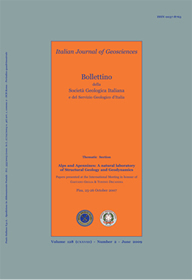
Basic stratigraphy and tectonics of the Southern Alps around the Giudicarie Lineament (Southern Alps, Italy)
Alberto Castellarin(*)
(*) Università di Bologna, Dipartimento di Scienze della Terra e Geologico Ambientali, Via Zamboni, 67 - I-40127 Bologna, Italy (e-mail: alberto.castellarin@unibo.it).
DOI: https://doi.org/10.3301/IJG.2009.128.2.409
Volume: 128 (2009) f.2
Pages: 409-417
Abstract
One of the most fascinating problems of the Southern Alps is the meaning of the strong structural indentation between the Sothern Alps and the Austroalpine units along N-Giudicarie fault, where the Europe-verging nappe stack of the Alps (Austroalpine and Penninic nappes) and the Africa-verging thrust belt of the Southern Alps face each other and appear sinistrally displaced more than 50 km. Starting from the beginning of ‘900 century, several generations of geologists considered the sinistral slip on the fault responsible of the indentation of the Alps along the Giudicarie lineament, occurred during N-S Neogene compressions. Old and new data, on the contrary, indicate that most of the extensive sinistral displacement affecting the N Giudicarie Lineament originated during late Cretaceous-early Eocene times. The Pre-Adamello structural belt is present only in the internal Lombardy zone, located W of the Adamello massif. This belt is unknown in the Dolomites and surrounding areas located to the E of the Giudicarie lineament. Upper Cretaceous-early Eocene thick Flysch deposits of Lombardy and Giudicarie are well preserved along the Southern and Eastern border of the Pre-Adamello belt (S-verging Alpine orogen). Towards the E, in the Dolomites and in the Carnic Alps and external Dinarides, only incomplete remnants of Flysch deposits, Aptian-Albian and Turonian-Maastrichtian in age, are present. They can be considered as equivalent to those of Lombardy and Giudicarie formerly in connection along the N-Giudicarie corridor. All these deposits may correspond to the foredeep syntectonic sedimentary records of the S border of the new Cretaceous-Eocene orogenic belt of the Alps. Differences between the eastern and western blocks (the Dolomites versus the pre-Adamello belt) can be related to the Cretaceous-Eocene N Giudicarie transfer zone, which produced the basic structural setting discussed here. Due to these data and interpretations the Giudicarie bending of the Alps appears to be a late Mesozoic-early Tertiary tectonic inheritance rather than the result of the Neogene compressional evolution. During the late Eocene to early Oligocene the transfer zone was utilized for the ascent and emplacement of the Paleogene Adamello batholith. Oligocene to Neogene compressional evolution inverted the N-Giudicarie fault into a back-thrust of the Austroalpine units over the South-Alpine chain rearranging most of the former structural setting.
Keywords
Flysch, Cretacico superiore, cintura di
sovrascorrimenti, faglia normale, zona di trasferimento, Lineamento Periadriatico.
Get Full Text